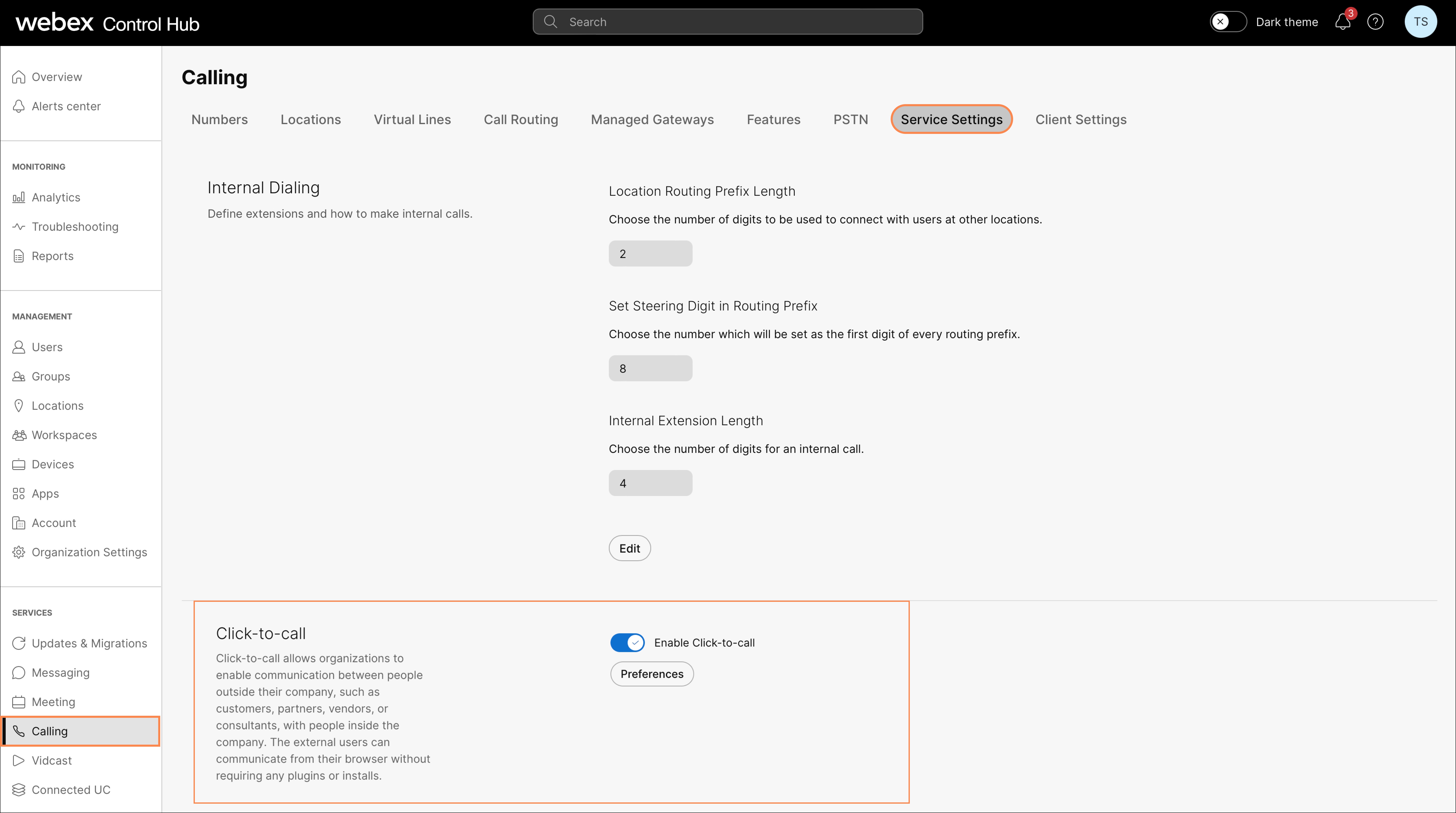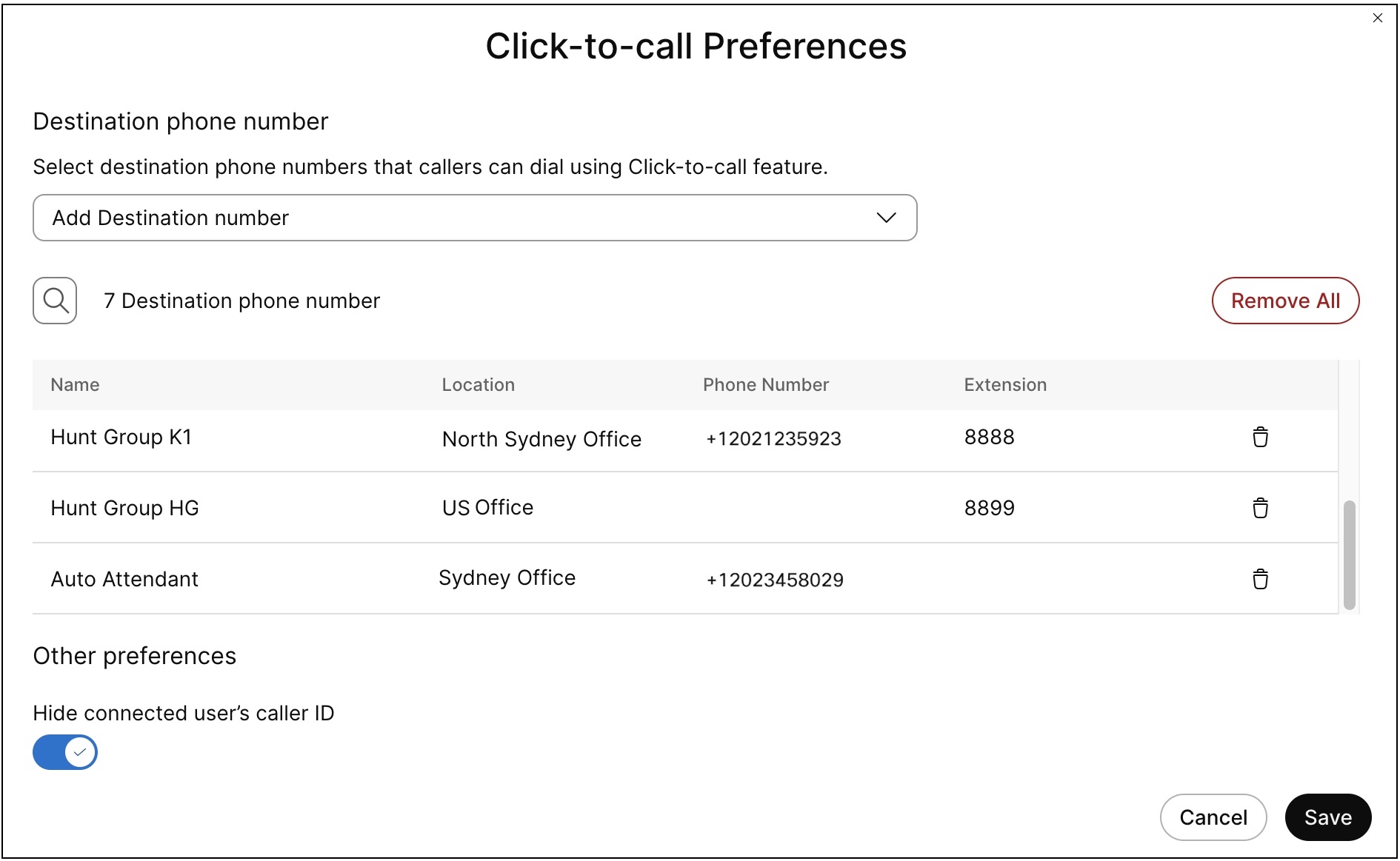- Hjem
- /
- Artikkel

Gjør det mulig for kunder å nå organisasjonen din ved hjelp av nettleserbasert klikk-for-å-ringe
 I denne artikkelen
I denne artikkelen Tilbakemelding?
Tilbakemelding?Klikk-for-å-ringe er en nettleserbasert funksjon som lar kunder koble seg til -organisasjonen din direkte via nettleseren sin, noe som gjør det enklere for dem å ringe deg.
Klikk-for-å-ringe lar kunder ringe inn til organisasjonen din ved hjelp av lyd direkte fra nettleseren sin, uten ytterligere programvarenedlastinger. Klikk-for-å-ringe gjør det enklere for kunder å kontakte dem for å få støtte, forespørsler eller konsultasjoner.
Klikk-for-å-ringe-funksjonen er bare tilgjengelig for organisasjoner med Webex Calling Customer Assist-lisensen.
Klikk-for-å-ringe-funksjonen er bare tilgjengelig for organisasjoner med Webex Calling Customer Assist.
Viktige funksjoner
-
Nettleserbasert tilgang: Kunder kan starte anrop fra hvilken som helst moderne nettleser uten ytterligere nedlastinger eller kompleks oppsett, noe som forenkler brukervennligheten.
-
Tilpassbar opplevelse som matcher organisasjonen needs: Du kan bruke Webex Calling SDK til å tilpasse kundeinteraksjonsopplevelsen i henhold til organisasjonens spesifikke behov og merkeidentitet.
-
Sømløs integrasjon med Webex Calling: Klikk-for-å-ringe fungerer med Customer Assist-organisasjonens automatiske svarere og samtalekøer.
-
Sikker kommunikasjon: Sørger for at alle samtaler er krypterte og sikre, og beskytter kundens data og personvern.
Fordeler
-
Forbedret kundeopplevelse: Gir kunder en enkel og problemfri måte å nå organisasjonen din på.
-
Forbedret effektivitet: Effektiviserer kommunikasjonsprosessen ved å gjøre det mulig for kundene å ringe agenter i Customer Assist-anropskøer.
-
Kostnadseffektiv: Reduserer behovet for ekstra programvarelisenser og vedlikehold.
Brukstilfeller
-
Kundestøtte: La kunder raskt komme i kontakt med supportrepresentanter for å få hjelp.
-
Salgsforespørsler: Gjør det mulig for potensielle kunder å spørre om produktinformasjon og konsultasjoner.
Konfigurer klikk-for-å-ringe i Kontrollhub
Gjennom kontrollhuben kan du aktivere klikk-for-å-ringe, konfigurere numre og justere preferanser, for eksempel personverninnstillinger.
Før du begynner
-
Organisasjonen din må ha Customer Assist-lisensen. For å tilordne en lisens, se Webex Calling kundestøtte.
-
Du kan ikke legge til et PSTN-nummer som et kundeanropsnummer.
-
Du kan bare legge til hovednummeret til Webex Calling Auto Attendant og Customer Assist Call Queue som måltelefonnumre som kunder kan ringe.
| 1 |
Logg inn på Kontrollhub. |
| 2 |
Gå til . |
| 3 |
Gå til delen Klikk for å ringe og slå på Aktiver Klikk for å ringe.  |
| 4 |
Klikk på Innstillinger. |
| 5 |
Fra rullegardinmenyen Legg til destinasjonsnummer søker du etter og velger numrene. Dette er hovednummeret til Webex Calling Auto Attendant eller Customer Assist-anropskøen, som kundene dine kan ringe.
|
| 6 |
Aktiver Skjul tilkoblet brukers anrops-ID for å skjule tilkoblet linjeidentitet fra kunder. Hvis du aktiverer dette alternativet, skjules navnet og telefonnummeret til personen kunden er koblet til, selv om samtalen overføres eller videresendes til noen andre. |
| 7 |
Klikk på Lagre. |
Hva du skal gjøre nå
Når du har konfigurert klikk-for-å-ringe-funksjonen, kan du opprette en klikk-for-å-ringe-widget.
Opprett en klikk-for-å-ringe-widget
Når du har konfigurert klikk-for-å-ringe i Kontrollhuben, kan du tilordne måltelefonnumrene til en klikk-for-å-ringe-widget på organisasjonens nettsted.
Kunder bruker widgeten til å ringe organisasjonen din. Basert på det konfigurerte nummeret blir samtalen rutet til den relevante brukeren eller funksjonene. Brukerne i organisasjonen kan svare på kundeanrop ved hjelp av Webex-appen eller telefonen.
Slik oppretter du en widget:
| 1 |
Lag en widget: |
| 2 |
Integrer Webex Calling SDK på nettsiden din: Se Webex Calling SDK for å komme i gang. Webex Calling SDK hjelper deg med å integrere lydanropsfunksjoner i løsningene dine. |
| 3 |
Konfigurer klikk-for-å-ringe-flyten: Se Web Calling SDK | Klikk-for-å-ringe for å sette opp klikk-for-å-ringe-flyten og implementere den ved hjelp av Webex Calling SDK. |
Ringeopplevelse for kundene dine
Kunder kan bruke nettleserne sine på datamaskinen eller mobilenheten for å starte samtalen, og de kan slå av eller på lyden under samtalen.
Støttede nettlesere:
-
Skrivebord (Windows og macOS)
-
Google Chrome 117 eller nyere
-
Microsoft Edge 117 eller nyere
-
Mozilla Firefox 118.0.2 eller nyere
-
Safari 17 eller nyere
-
-
Mobil (Android og iOS)
-
Google Chrome 117 eller nyere
-
Safari 16 eller nyere
-
- En kunde som ringer inn til organisasjonen din kan ikke motta et anrop.
- En kunde som ringer inn til organisasjonen din kan ikke sette samtaler på vent, gjenoppta eller overføre samtaler, men den oppringte brukeren kan bruke disse funksjonene.



